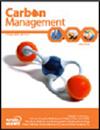A simple concept for estimating deadwood carbon in forests
IF 3.2
4区 环境科学与生态学
Q3 ENVIRONMENTAL SCIENCES
引用次数: 0
Abstract
Abstract Deadwood in forests is becoming an important topic globally for forest management and carbon markets. While deadwood volume is now routinely assessed by forest inventories and can be even monitored using remote sensing, data about deadwood carbon and density depending on the extent of decay is scarce. We propose a simple concept for estimating deadwood carbon using data from a pilot study in selected coniferous and broadleaf forests covering different climate zones in Austria. We measured deadwood volume and decay classes and calculated deadwood density and carbon fraction from destructive field samples. We found that decay reduces deadwood density significantly, while carbon fraction increases moderately with decay. Partitioning the explained variation confirmed that size and site parameters are more important for explaining deadwood carbon fraction than for deadwood density. These patterns were consistent for coniferous and broadleaf tree species. We also show how to estimate deadwood carbon stocks using standard forest inventory measurements or country statistics, without information on decay classes. We found differences in decay classes of standing versus lying deadwood, and our proposed method allows considering this in large-scale deadwood carbon assessments. We highlight research gaps and missing deadwood information, to provide more accurate carbon assessments of deadwood.估算森林枯木碳的一个简单概念
本文章由计算机程序翻译,如有差异,请以英文原文为准。
求助全文
约1分钟内获得全文
求助全文
来源期刊

Carbon Management
ENVIRONMENTAL SCIENCES-
CiteScore
5.80
自引率
3.20%
发文量
35
期刊介绍:
Carbon Management is a scholarly peer-reviewed forum for insights from the diverse array of disciplines that enhance our understanding of carbon dioxide and other GHG interactions – from biology, ecology, chemistry and engineering to law, policy, economics and sociology.
The core aim of Carbon Management is it to examine the options and mechanisms for mitigating the causes and impacts of climate change, which includes mechanisms for reducing emissions and enhancing the removal of GHGs from the atmosphere, as well as metrics used to measure performance of options and mechanisms resulting from international treaties, domestic policies, local regulations, environmental markets, technologies, industrial efforts and consumer choices.
One key aim of the journal is to catalyse intellectual debate in an inclusive and scientific manner on the practical work of policy implementation related to the long-term effort of managing our global GHG emissions and impacts. Decisions made in the near future will have profound impacts on the global climate and biosphere. Carbon Management delivers research findings in an accessible format to inform decisions in the fields of research, education, management and environmental policy.
 求助内容:
求助内容: 应助结果提醒方式:
应助结果提醒方式:


